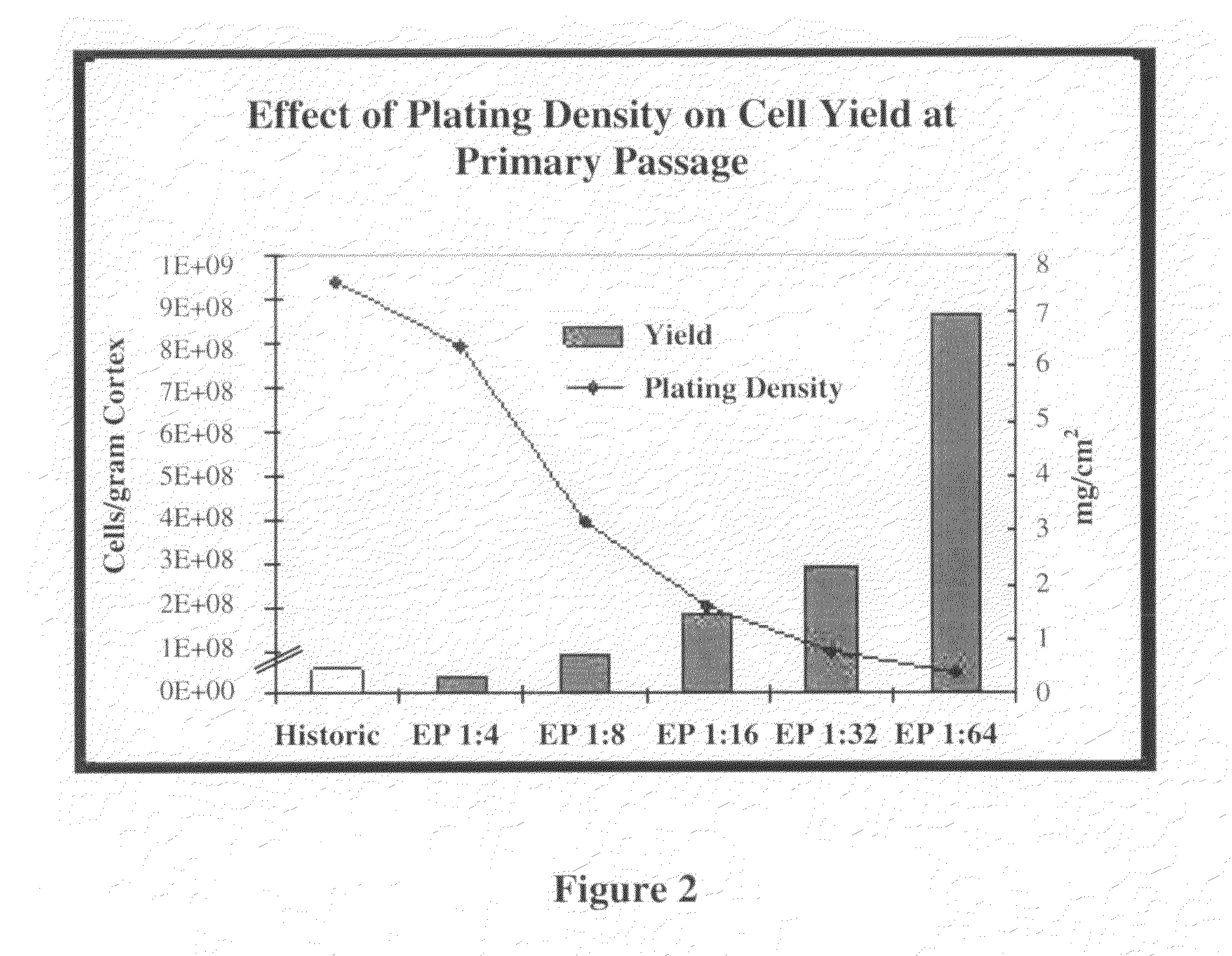Methods for Enhanced Propagation of Cells
a cell and cell technology, applied in the field of cell isolation and cell propagation, can solve the problems of multiorgan dysfunction, ineffective current therapies for acute decompensation of heart failure with renal insufficiency, and the risk of death is 5 to 8 fold higher, so as to improve the quality of life, enhance the cell propagation, and enhance the effect of kidney cell expansion
- Summary
- Abstract
- Description
- Claims
- Application Information
AI Technical Summary
Benefits of technology
Problems solved by technology
Method used
Image
Examples
example 1
[0056]A pilot study was initiated using a porcine kidney to determine which variables have an effect on REC propagation. The variables tested included enzymatic digestion, particle size, centrifugation, plating density and media changes, plating matrix, subculture conditions, and the use of differentiation factors. In accordance with the invention, more efficient digestion of cortex tissue generated slurry that included precursor cells with enhanced proliferative potential. The slurry was further separated by size, and higher centrifugal force was applied to better retain precursor cells. Other variables such as diluting plating density, partial media changes, subculture conditions (e.g., passage ratio), and the retention of non-adherent cells contributed to the prolonged maintenance of a proliferative environment. It is contemplated that any one, or any combination of two or more, of these variables can be used to improve cell yield in accordance to the invention.
[0057](1) Methods
[...
example 2
[0075]This Example shows application of enhanced propagation techniques according to the invention to human RECs (HRECs) and the improved outcome of these techniques. More specifically, the Example describes (1) application of the enhanced propagation techniques to increase REC yield from human kidneys; (2) evaluation of the equivalence of HRECs obtained using the historic method and those obtained using enhanced propagation techniques according to the invention; (3) evaluation of the effects of cryopreservation on HREC identity and yield; and (4) integration of cryopreserved HREC obtained using enhanced propagation techniques according to the invention into a Bioartificial Renal Epithelial Cell System (BRECS), a type of WEB AK device.
[0076](1) Parameters to Enhance REC Yield from Human Kidneys
[0077]Rationale: The historic isolation protocol for REC is focused on the maintenance of fully differentiated epithelial sheets and greatly sacrifices the proliferation potential of isolated ...
example 3
[0110]Cell therapy in chronic care situations may benefit from the use of autogenic cells, such that patient's own cells can be sampled, grown, and used in a therapeutic device used to treat that patient. This example demonstrates the feasibility of an autologous device manufactured for chronic applications using cells from a punch biopsy.
[0111]Punch Biopsy: A punch biopsy procedure was used to demonstrate the feasibility of autologous device manufacture for chronic applications using diseased kidney. Kidney tissue biopsies are routinely performed to aid in the diagnosis of renal disease. It follows that if the improved cell yield demonstrated using cells obtained from whole kidney and using EP methods according to the invention can be applied to small biopsies, autologous devices may be manufactured. Typically, a 14-18 gauge biopsy needle is used to remove a 1 cm long core of tissue from the kidney for diagnosis. To mimic this procedure, a glass Pasteur pipet with a 1.2 mm diameter...
PUM
| Property | Measurement | Unit |
|---|---|---|
| size | aaaaa | aaaaa |
| particle sizes | aaaaa | aaaaa |
| surface area | aaaaa | aaaaa |
Abstract
Description
Claims
Application Information
 Login to View More
Login to View More - R&D
- Intellectual Property
- Life Sciences
- Materials
- Tech Scout
- Unparalleled Data Quality
- Higher Quality Content
- 60% Fewer Hallucinations
Browse by: Latest US Patents, China's latest patents, Technical Efficacy Thesaurus, Application Domain, Technology Topic, Popular Technical Reports.
© 2025 PatSnap. All rights reserved.Legal|Privacy policy|Modern Slavery Act Transparency Statement|Sitemap|About US| Contact US: help@patsnap.com



